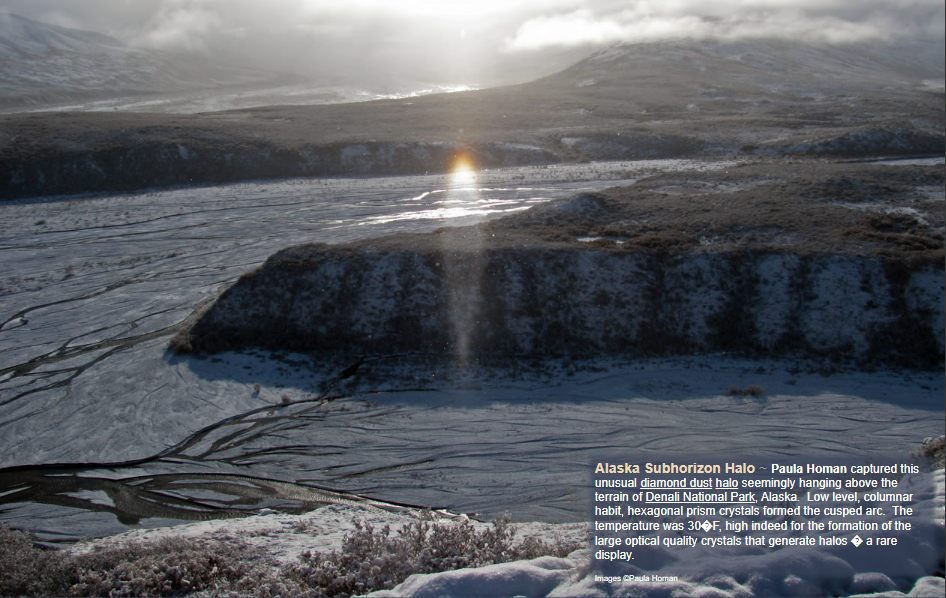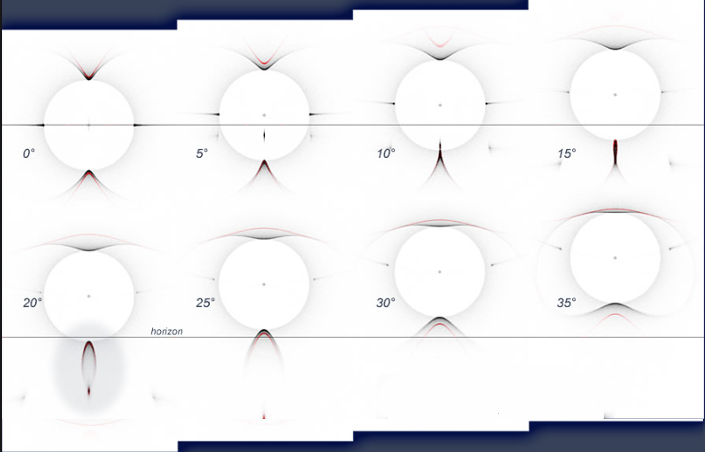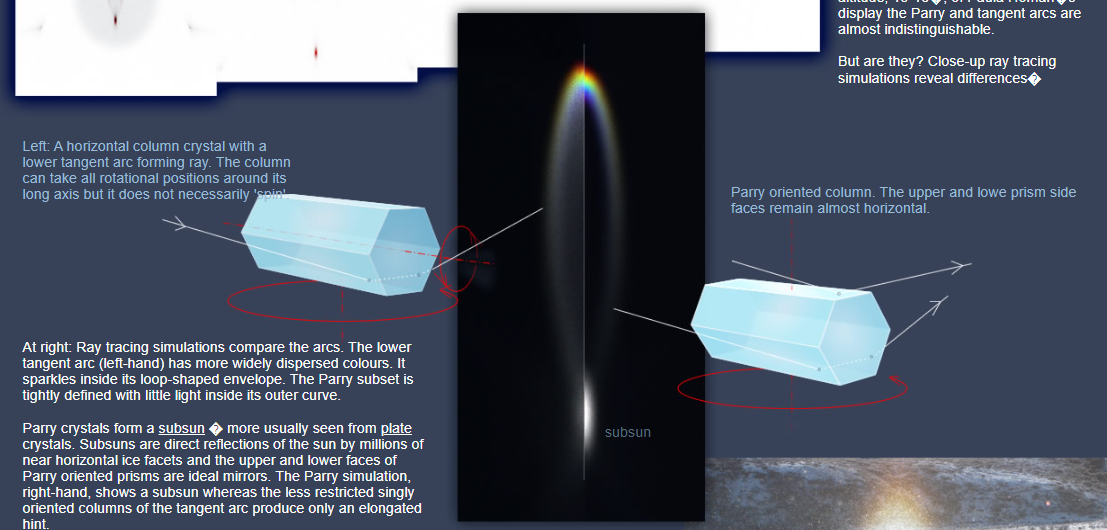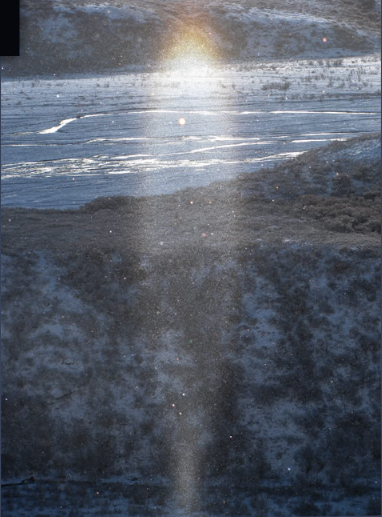OPOD - Alaska Halos
OPOD - Alaska Halos: A Rare and Enchanting Atmospheric Phenomenon
Alaska is known for its stunning landscapes and breathtaking natural wonders. Among these wonders are the mesmerizing halos that occasionally grace the skies above Denali National Park. One such halo, captured by Paula Homan, showcases an unusual display of diamond dust crystals suspended above the terrain. This captivating spectacle is the result of low-level temperatures, hexagonal prism crystals, and the perfect conditions for the formation of large, high-quality crystals that generate halos.
Halos, often seen as luminous rings or arcs around the sun or moon, are optical phenomena caused by the interaction of light with ice crystals in the atmosphere. While halos are not uncommon, the Alaska subhorizon halo observed by Paula Homan stands out due to its unique characteristics and rarity.
Tangent Arcs and Parry Arcs: Exploring the Differences
The formation of tangent arcs and Parry arcs involves columnar ice crystals with similar ray paths passing through prism side faces at different angles. The distinction between these two types of arcs lies in their orientational freedom. Tangent arc crystals have the ability to rotate in various positions around their near-horizontal long axis, while Parry crystals remain fixed with two side faces near-horizontal.
- Tangent arcs and Parry arcs both change shape dramatically as the sun rises.
- At sunrise, Parry arcs spread wide and gradually close into a loop before opening again.
- At an altitude of 15-18°, Parry and tangent arcs become almost indistinguishable.
However, close-up ray tracing simulations reveal subtle differences between the two types of arcs. The lower tangent arc exhibits a wider dispersion of colors and sparkles within its loop-shaped envelope. On the other hand, the Parry arc is tightly defined with minimal light inside its outer curve.
Subsuns and Mirror-Like Prisms
Parry-oriented column crystals not only contribute to the formation of arcs but also give rise to a fascinating atmospheric phenomenon known as a subsun. Subsuns are direct reflections of the sun caused by millions of near-horizontal ice facets acting as mirrors. The upper and lower faces of Parry-oriented prisms serve as ideal surfaces for creating subsuns.
- Subsuns are more commonly associated with plate crystals, making their occurrence with Parry crystals even more remarkable.
- The Parry simulation reveals a distinct subsun, while the tangent arc produces only a faint elongated hint.
The Alaska halo display, captured by Paula Homan, is likely a lower tangent arc with the possibility of some Parry arc presence. The perfection and rarity of such a display, especially considering the low-level crystal formation just below freezing temperatures, make it an enchanting sight comparable to spotting a wolverine in the wild.
In conclusion, Alaska's halos offer a glimpse into the extraordinary beauty and complexity of atmospheric optics. The interplay between temperature, crystal structure, and light refraction creates these awe-inspiring displays. As we marvel at the intricate patterns and vibrant colors painted across the sky, we are reminded of the vast wonders that nature has to offer.

Alaska Subhorizon Halo ~ Paula Homan captured this unusual diamond dust halo seemingly hanging above the terrain of Denali National Park, Alaska. Low level, columnar habit, hexagonal prism crystals formed the cusped arc. The temperature was 30�F, high indeed for the formation of the large optical quality crystals that generate halos � a rare display.

Lower Tangent or Lower Parry Arc?
Column crystals form both and they have the same rays paths passing through a prism side face and leaving through another inclined 60�.
Orientational freedom makes the difference.
Tangent arc crystals can take all rotational positions around their near horizontal long axis (see below). Parry crystals cannot. Instead they float fixed with two side faces near horizontal. Parry arcs are therefore a subset of tangent arcs and their sharp forms and colours always reside inside the �fuzz� of the less well defined tangent arcs.
Parry and tangents arcs change shape dramatically as the sun rises. In the HaloSim ray tracings at left Parry arcs are coloured red. At sunrise the lower arcs are spread wide. As the sun climbs they close into a loop and then open again. At the sun altitude, 15-18�, of Paula Homan�s display the Parry and tangent arcs are almost indistinguishable.
But are they? Close-up ray tracing simulations reveal differences

Parry oriented column. The upper and lowe prism side faces remain almost horizontal.
Left: A horizontal column crystal with a lower tangent arc forming ray. The column can take all rotational positions around its long axis but it does not necessarily 'spin'.
At right: Ray tracing simulations compare the arcs. The lower tangent arc (left-hand) has more widely dispersed colours. It sparkles inside its loop-shaped envelope. The Parry subset is tightly defined with little light inside its outer curve.
Parry crystals form a subsun � more usually seen from plate crystals. Subsuns are direct reflections of the sun by millions of near horizontal ice facets and the upper and lower faces of Parry oriented prisms are ideal mirrors. The Parry simulation, right-hand, shows a subsun whereas the less restricted singly oriented columns of the tangent arc produce only an elongated hint.
The Alaskan display is therefore likely a more common lower tangent arc although some Parry arc might also be present. Yet such lone perfection, particularly from low level crystals only just below freezing, is rare � maybe as rare or rarer as spotting a wolverine!
Thanks to Walter Tape & Marko Riikonen for discussion.

Note: this article has been automatically converted from the old site and may not appear as intended. You can find the original article here.
Reference Atmospheric Optics
If you use any of the definitions, information, or data presented on Atmospheric Optics, please copy the link or reference below to properly credit us as the reference source. Thank you!
-
<a href="https://atoptics.co.uk/blog/opod-alaska-halos/">OPOD - Alaska Halos</a>
-
"OPOD - Alaska Halos". Atmospheric Optics. Accessed on April 18, 2024. https://atoptics.co.uk/blog/opod-alaska-halos/.
-
"OPOD - Alaska Halos". Atmospheric Optics, https://atoptics.co.uk/blog/opod-alaska-halos/. Accessed 18 April, 2024
-
OPOD - Alaska Halos. Atmospheric Optics. Retrieved from https://atoptics.co.uk/blog/opod-alaska-halos/.